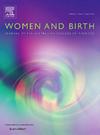Diversity of representation in pregnancy research: A national mixed-methods survey of women’s perceptions and experiences in the United Kingdom
IF 4.1
2区 医学
Q1 NURSING
引用次数: 0
Abstract
Aim
To explore the experiences and perceptions of women who may take part in antenatal research, including their perceived motivators, enablers, and barriers to participating in research with a sub-analysis of under-represented groups.
Methods
A mixed-methods parallel explanatory design was employed, and a national semi-structured online survey was circulated nationally using a start to end participatory framework. Likert scale responses and participant experience and demographic data were cross-tabulated to explore the differences between groups using descriptive and non-parametric statistics. A content analysis was used to explore open-ended questions and generate coding clusters. The qualitative and quantitative results were then merged using a using a pillar integration process.
Findings
There were 260 survey responses across the UK, from Oct to Nov 2021 as part of wider research. Three meta-themes were developed from the merged integration: 1. Participation being mediated by perceptions and experience of safety, convenience, and communication, 2. Lived experience and education may increase access to research participation, and 3. Sociocultural differences may lead to research hesitancy.
Conclusion
Clinical researchers and research delivery teams working in antenatal settings, have the potential to impact the inclusion of underserved communities through facilitative research designs, well considered communication strategies, and authentic relationships which support participant education about research.
妊娠研究中代表性的多样性:一项针对英国妇女观念和经验的全国性混合方法调查
目的探讨可能参与产前研究的妇女的经历和看法,包括她们参与研究的动机、促成因素和障碍,并对代表性不足的群体进行亚分析。方法采用混合方法平行解释设计,并采用从开始到结束的参与式框架在全国范围内进行全国性半结构化在线调查。李克特量表反应和参与者经验和人口统计数据被交叉表,以探索使用描述性和非参数统计组之间的差异。内容分析用于探索开放式问题并生成编码簇。定性和定量的结果,然后使用一个使用支柱集成过程合并。作为更广泛研究的一部分,从2021年10月到11月,英国各地共有260份调查回应。从合并的集成中开发出三个元主题:2.安全、便利和沟通的感知和经验对参与的调节作用。2 .生活经验和教育可以增加参与研究的机会;社会文化差异可能导致研究犹豫不决。结论:在产前环境中工作的临床研究人员和研究交付团队,有可能通过促进研究设计、深思熟虑的沟通策略和支持参与研究教育的真实关系来影响服务不足社区的纳入。
本文章由计算机程序翻译,如有差异,请以英文原文为准。
求助全文
约1分钟内获得全文
求助全文
来源期刊

Women and Birth
NURSING-OBSTETRICS & GYNECOLOGY
CiteScore
7.20
自引率
13.20%
发文量
371
审稿时长
27 days
期刊介绍:
Women and Birth is the official journal of the Australian College of Midwives (ACM). It is a midwifery journal that publishes on all matters that affect women and birth, from pre-conceptual counselling, through pregnancy, birth, and the first six weeks postnatal. All papers accepted will draw from and contribute to the relevant contemporary research, policy and/or theoretical literature. We seek research papers, quality assurances papers (with ethical approval) discussion papers, clinical practice papers, case studies and original literature reviews.
Our women-centred focus is inclusive of the family, fetus and newborn, both well and sick, and covers both healthy and complex pregnancies and births. The journal seeks papers that take a woman-centred focus on maternity services, epidemiology, primary health care, reproductive psycho/physiology, midwifery practice, theory, research, education, management and leadership. We also seek relevant papers on maternal mental health and neonatal well-being, natural and complementary therapies, local, national and international policy, management, politics, economics and societal and cultural issues as they affect childbearing women and their families. Topics may include, where appropriate, neonatal care, child and family health, women’s health, related to pregnancy, birth and the postpartum, including lactation. Interprofessional papers relevant to midwifery are welcome. Articles are double blind peer-reviewed, primarily by experts in the field of the submitted work.
 求助内容:
求助内容: 应助结果提醒方式:
应助结果提醒方式:


